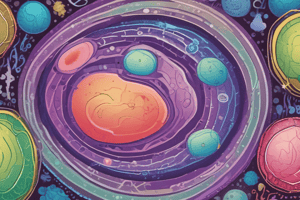Podcast
Questions and Answers
What is the primary function of the rough endoplasmic reticulum?
What is the primary function of the rough endoplasmic reticulum?
- ATP synthesis by oxidative phosphorylation
- Modification and sorting of proteins
- Detoxification of substances
- Translation of mRNA into membrane-associated proteins (correct)
Which component is responsible for intracellular degradation?
Which component is responsible for intracellular degradation?
- Lysosome (correct)
- Peroxisome
- Rough endoplasmic reticulum
- Golgi apparatus
What is the function of the Golgi apparatus?
What is the function of the Golgi apparatus?
- Modification, sorting, and packaging of proteins (correct)
- Detoxification of substances
- Translation of mRNA
- Storage of calcium ions
What role does the cytoskeleton play within the cell?
What role does the cytoskeleton play within the cell?
Which organelle is involved in the storage of calcium ions?
Which organelle is involved in the storage of calcium ions?
What is the main function of free ribosomes?
What is the main function of free ribosomes?
What is the first step in the secretory pathway of proteins that will leave the cell?
What is the first step in the secretory pathway of proteins that will leave the cell?
Which organelle assists in the removal of receptors from the plasma membrane?
Which organelle assists in the removal of receptors from the plasma membrane?
Which subunit of ribosomes is responsible for binding the incoming aminoacyl-tRNA?
Which subunit of ribosomes is responsible for binding the incoming aminoacyl-tRNA?
What is the primary function of mitochondria?
What is the primary function of mitochondria?
Which type of processing occurs in the Golgi apparatus?
Which type of processing occurs in the Golgi apparatus?
What is a primary function of the Smooth Endoplasmic Reticulum?
What is a primary function of the Smooth Endoplasmic Reticulum?
What modification does the Golgi apparatus perform to proteins before sending them to their final destinations?
What modification does the Golgi apparatus perform to proteins before sending them to their final destinations?
What is the role of lysosomes in the cell?
What is the role of lysosomes in the cell?
In what type of cells would you expect to find an enlarged Smooth Endoplasmic Reticulum?
In what type of cells would you expect to find an enlarged Smooth Endoplasmic Reticulum?
What is the function of the E-site in ribosomes?
What is the function of the E-site in ribosomes?
Flashcards are hidden until you start studying
Study Notes
Levels of Organization
- Organization of life progresses from atoms to ecosystems.
- Cell function depends on the organelles and their components.
- Proteins and lipidic membranes interact.
Cytoplasm
-
Cytosol: Contains free ribosomes involved in protein synthesis, and also carries out metabolism.
-
Cytoskeleton: Provides cell shape and movement, and helps with intracellular transport.
Nucleus
- Contains the genome, comprised of 22 autosomes and 2 sex chromosomes.
- Site of DNA and RNA synthesis.
Mitochondria
- Site of ATP synthesis through oxidative phosphorylation.
- Stores Calcium ions (Ca2+).
Smooth Endoplasmic Reticulum (SER)
- Synthesizes lipids.
- Stores Calcium ions (Ca2+).
Free Ribosomes
- Translate mRNA into cytosolic proteins.
Rough Endoplasmic Reticulum (RER)
- RER ribosomes translate mRNA into membrane-associated proteins destined for secretion or for incorporation into cell membranes.
Lysosome
- Degrades intracellular material through enzymatic breakdown.
Endosome
- Takes up cholesterol, removes receptors from the plasma membrane.
- Helps in small molecule and water uptake, and internalizes large particles like bacteria and cell debris.
Golgi Apparatus (Complex)
- Acts as a distribution center for proteins and lipids, adding sorting signals and packaging them for delivery to other organelles or secretion.
- Modifies protein structure through post-translational modifications (adding O-oligosaccharides and modifying N-oligosaccharides).
Proteosome
- Degrades intracellular proteins.
Peroxisome
- Detoxifies substances.
The Secretory Pathway
- Proteins destined for secretion outside the cell follow a specific pathway.
- The pathway starts with protein synthesis on RER ribosomes.
- Proteins are transported to SER for modifications.
- Further modifications occur in the Golgi complex.
- Finally, proteins are placed in secretory vesicles.
Ribosomes
- Site of protein synthesis during translation of RNA into protein.
- Composed of two subunits in animal cells (60S and 40S).
- Interact with amino acids at specific sites:
- A-site: binds incoming aminoacyl-tRNA guided by the codon.
- P-site: binds peptidyl-tRNA carrying the growing amino acid chain.
- E-site: releases empty tRNA.
Endoplasmic Reticulum
- RER membrane extends from the nucleus.
- Proteins synthesized on RER ribosomes can be destined for:
- Inside organelles as enzymes.
- Cell membranes or organelle membranes.
- Secretion as hormones, extracellular matrix, etc.
- N-linked glycosylation occurs in the Endoplasmic Reticulum.
- SER synthesizes steroids and detoxifies toxins using cytochrome P450 enzymes.
- Abundant in steroid hormone producing cells and liver cells (hepatocytes).
Golgi Apparatus (or Complex) & Lysosomes
- Golgi is a distribution center for proteins and lipids, sending vesicles to the cell membrane (trans) and back to the ER (cis).
- Post-translational modifications occur in the Golgi, such as:
- Adding O-oligosaccharides to serine and threonine.
- Modifying N-oligosaccharides on asparagine.
- Tagging proteins for their final destinations.
- Lysosomes are formed from endosomes by acquiring digestive enzymes and pH regulating membrane channels.
- Lysosomes can fuse with other vesicles (phagosomes, autophagosomes) for digestion.
Studying That Suits You
Use AI to generate personalized quizzes and flashcards to suit your learning preferences.




